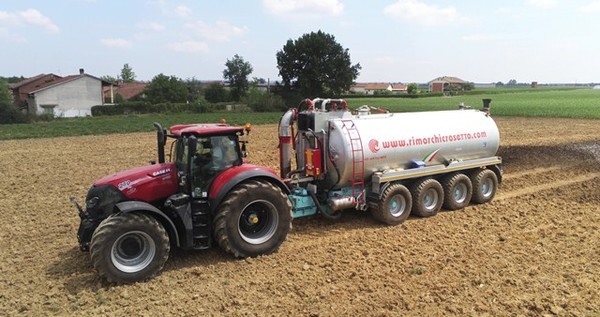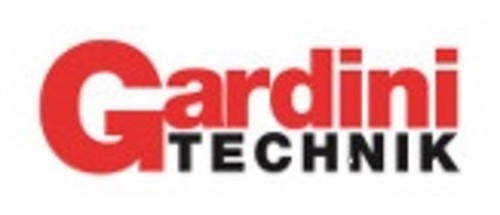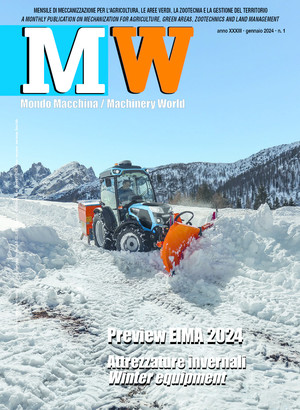
Manure spreaders: management of the waste
To provide crops with the nutrients required and, at the same time, dispose of substances that would otherwise pollute, it is essential to correctly distribute the livestock waste in the field. The technological solutions offered by the industries are increasingly efficient and adapt to different business needs
The Italian livestock sector is increasingly oriented towards large-scale intensive farming, often performed on farms with limited arable land. In this framework, about 150 million tons of wastewater, or 600.000 tons of nitrogen, 160.000 of phosphorus and 380.000 of potassium, must be disposed of, still, elements to be fully considered resources. These wastes, particularly those in liquid form, are seen by farmers as more of a management problem than a source of income, and therefore a cause of economic burden. The direct consequence is the lack of agronomic enhancement of this by-product, above all because of the environmental complications that may arise, such as nitrate contamination of surface water and groundwater, or accumulation of phosphorus and heavy metals in the soil, or even high ammonia and malodorous substances emissions in the atmosphere. However, the primary objective still is the correct and balanced distribution of the livestock waste in the field, also because it brings to more efficient exploitation of nutrients by the crop, and therefore to a reduction of soil and air pollution. The choice of the most suitable equipment on a case-by-case basis, tailored to the real environmental needs, makes it possible to ensure the proper supply of nutrients to the soil, to contain nitrogen losses, to reduce soil compaction and the emission of odors, decreasing at the same time transport and distribution costs. Many national manufacturers have a central place worldwide also in the spreader sector, offering innovative solutions aimed at optimizing the spreading, with measurable economic and environmental advantages.
Pressurized or not?
Basically, manure spreaders consist of a tank and a set of devices for getting to the right pressure, adjust the dose and spread the product. The main constructive differences are mainly due to the slurry loading procedures which, in short, can be done either by introducing air into the tank (in models with pressurized tanks) or by the direct action of the product through volumetric or centrifugal pumps (in models with atmospheric pressure tank).
The machines of the first type are undoubtedly the most widespread today: they work at relatively low pressures (0.5-2 bar), moreover, they need to reach them only for short periods of operation. Conversely, in atmospheric pressure manure spreaders, the tank is essentially a container of the product and can, therefore, be made with profiles and sheets of lesser thickness. Compared to those with pressurized tanks, this leads to a significant reduction of both the unladen mass and the cost. On the other hand, that solution is characterized by faster wear and a higher danger of blockage.
Soil compaction
Anyway, due to the decidedly high mass (particularly fully loaded), all the manure spreads inevitably cause remarkable soil compaction. Aware of this problem, manufacturers have developed various technical solutions to limit the damage to the soil structure, including the offset of the rear axle compared to the front one (to distribute the load on a larger surface), a technical peculiarity applied nowadays almost always on self-propelled versions. In parallel, it is highly recommended to fit tires with large section and low inflation pressure, or even better, devices capable of varying the pressure, for example from just over 1 bar in the field, then properly increasing the value to minimize forward resistance on the road.
However, the most effective technique, but undoubtedly the most articulated to achieve, is the so-called "umbilical" technique, which involves the distribution in the field carried out by light equipment (often suitable for direct burial of the product), connected by a pipe to a tank placed at the edge of the field or even directly at the storage tank.
Odorous emissions and nitrogen volatilization
To enhance the fertilizing capacity, reduce the volatilization of ammoniacal nitrogen and the leaching of nitrates, it is necessary to limit the exposure time and the contact surfaces between the sewage and the atmosphere to the minimum.
Obviously, to select the most appropriate solution, the presence or absence of the crop must be taken into account. In any case, it is always even better to choose the ground-level application with immediate burial or better, the direct subsurface incorporation. Contraindicated are the high-pressure distribution methods (due to the high volatilization risks), and the deep injection (which causes nitrogen losses by leaching). It should also be considered that the subsurface spreading with a closed furrow is feasible with the equipment also suitable for weed crops, which contributes to increasing the period for distribution in the field in the spring-summer period.
Uniform distribution
The liquid waste of zootechnical origin contains nitrogen, phosphorus, potassium and organic substance in different concentrations and with very variable contents, not only concerning the feeding of the herd but also to the storage and transport methods of the by-product.
The need to comply with the regulatory limits of nitrogen that can be spread in the field (170 kg/ha in vulnerable areas and 340 in non-vulnerable ones) assumes that the concentration of this element in the wastewater is known, even better when it is spread. It can, therefore, be assumed that it is important first of all spreading the manure evenly, both transversally and longitudinally, and comply as closely as possible with any prescription maps of the various nutrients, always keeping an eye on the aforementioned maximum permissible loads.
It is therefore very important to adopt the most suitable spreading devices, even better if supported by satellite devices for semi-automatic or assisted driving, to avoid overlapping and underdosing. The next, decisive step is the continuous monitoring of the chemical-physical composition of the product, detecting its variability according to its position (or stratification) in the tank.
This context, which is fully part of precision agriculture, allows supplying nutrients according to the real agronomic needs, minimizing the impacts on the atmosphere and the aquifer. Although the site-specific management of livestock manure is not yet a common practice, it is certainly an objective to be pursued, while also taking into consideration all the other fertilizer inputs of a different nature, with the awareness that the agricultural soil is a highly complex whole, absolutely uneven and dynamic, in time and space.
The Mother Regulation on manure spreaders
The EU Regulation 167/2013 (Mother Regulation, MR) has set new rules for the tractors, trailers and trailed operating agricultural machinery road homologation since 2018. More specifically, the MR establishes the mandatory European approval for tractors (cat. T), while for trailers (cat. R), and also for interchangeable towed equipment (cat. S) the manufacturer can choose whether to follow the MR or comply with the old national regulations.
It is therefore important to specify the difference between "trailers" and "interchangeable towed equipment", which lies in the ratio between maximum technically permissible full load and empty mass: if this value is equal to or greater than 3 it is about trailers. Conversely, the vehicle must be considered as interchangeable towed Vehicles cat. R have their own license plate, while the cat. S circulate with the tractor number plate.
In any case, the most striking difference introduced by the new legislation concerns the increase in flow rates: it is now possible to load up to 9.000 kg on each axis, to which it must be added the allowable load on the tow hook, which varies from 2.000 to 4.000 kg depending on the type. This means that for a 4-axle trailer the permissible deadweight capacity on the road can reach 40.000 kg, which is twice the previous national limit.
Another significant novelty is that the MR allows the type-approval of the manure spreaders with a maximum speed up to 60 km/h; moreover, in Italy the Ministry of Transport has decided to maintain the previous limit of 40 km/h, so that, even if structured for 60 km/h, any model cannot travel beyond the Italian limit. Furthermore, it is now possible to tow an MR vehicle with a non-MR tractor, provided that the hitch is compatible with the eye of the MR machinery, with the course obviously restricted to the national limit set.








